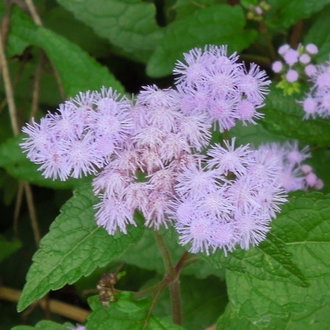White Snakeroot vs Blue Mistflower
This guide is under construction and has not been published yet. It may have errors. When in doubt, double-check other sources for definitive ID.These plants are easy to distinguish when blooming, but harder to tell apart when they are not blooming. Rarely, blue mistflower blooms white, which can further confusion, but plants can be distinguished by growth habit and leaf shape. Their ranges overlap over a large region. Leaf shape and other leaf characteristics are variable on both species, which makes identification by leaves difficult.
White Snakeroot (Ageratina altissima) | Blue Mistflower (Conoclinium coelestinum) |
A poisonous perennial herb native to eastern North America. One of the most common members of the Eupatorieae tribe of the aster family. In much of its range, among the last wildflowers to bloom in fall. | A low-growing rhizomatous perennial of moist, sunny areas, with blueish lavender flowers and opposite, triangular leaves. |
Always has white flowers. Photo © Matt Berger, CC BY 4.0. | Usually has lavender-blue flowers, but may rarely have white flowers. Photo © , CC BY-SA 4.0. |
Clumping growth habit; short rhizomes cause clumps to grow in extent, but longer-distance reproduction is mostly by seed. Photo © Alaina Larkin, CC BY 4.0. | Spreads underground by long rhizomes; stems sometimes root at nodes. Can form large colonies by vegetative reproduction. Photo © , CC BY-SA 4.0. |
Leaf margins are more coarsely serrated; leaf tips usually acuminate, tapering to a point. Photo © aarongunnar, CC BY 4.0. | Leaf margins average less coarsely serrated, and may be crenate (with rounded teeth); leaf tips are acute, not tapering to a long point. Photo © Robb Hannawacker, Public Domain. |
References & External Resources
These short lists show only links helpful for ID. For a complete list of references and resources also covering other aspects of ecology, visit the links section of the full article on each plant, which is the first entry here.








